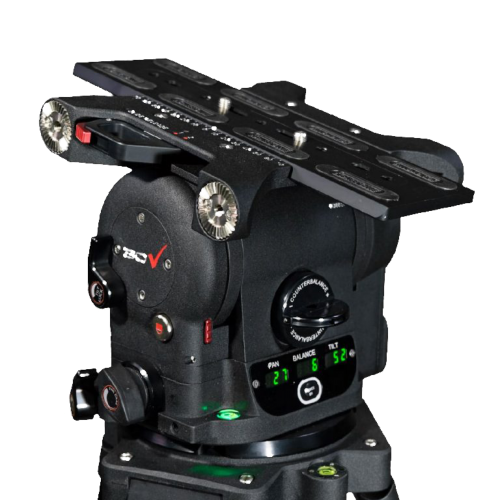A story of success
Cartoni designs, manufactures and markets
highly professional support hardware
and systems for
the motion picture and television industries.

Cartoni presents:
Fluid Heads Flat base
Maxima 30
From almost freewheeling to a consistent maximum
drag, along with super precise
starts and stops, the Maxima 30 offers an unprecedented quality of movement in a
compact fluid head.

The Maxima 30 fluid head is designed for
the latest Digital Cinematography cameras
with a payload capacity from 3 kg (7 lbs) to 40 kg (88 lbs).
Cartoni patented flawless counterbalance,
combined with the patented “Planetary” fluid
mechanism make the Maxima 30 the ideal support
for todays’ sophisticated cinematographers,
seeking a fluid head for perfectly smooth operation.

From almost freewheeling to a
consistent maximum drag, along with
super precise starts and stops, the Maxima 30
offers an unprecedented quality of
movement in a compact fluid head.
Key features:
+/- 90° tilt range
- Flat Mitchell base
- Continuous fluid drag and continuous counterbalance
- Perfect balance at any tilt angle
- Ergonomic brake levers and operating knobs
- Horizontal lock
- Large quick release, side-load sliding camera plate
- Digital readouts and illuminated spirit level
- Telescopic pan bar and short front pan bar
Constant innovation has ensured the company’s success. CARTONI owns and uses 36 different patents
on Fluid Action and Counterbalance Systems
With a variety of 23 different fluid heads calibrated in capacity and performance for every shooting need,
Cartoni offers the widest range of fluid camera support heads on the market.
W
ildlife
documentary
from
Grizzly
Creek
Films,
Wildpath
and
Appian
Way
underscores
the
plight
of
the
endangered cat native to Florida’s Everglades (
Cartoni Focus 22
)
Danny
Schmidt
is
an
award-winning
director,
producer
and
cinematographer
whose
work
in
wildlife
documentaries
has
taken
him
to
the
most
remote
and
forbidding
parts
of
the
globe
in
search
of
its
most
elusive
creatures.
In
one
of
his
latest
projects,
Schmidt
served
as
cinematographer
on
Path
of
the
Panther
,
a
feature-
length
documentary
directed
by
Eric
Bendick
and
produced
by
Carlton
Ward
,
Jr
for
National
Geographic
.
The
film
centers
on
the
Florida
panther,
a
rarely
seen
creature
whose
habitat
is
threatened
by
the
ecological
degradation
of
the Everglades.
Capturing
imagery
of
a
stealthy
and
potentially
dangerous
animal
like
the
Florida
panther,
requires
skill,
daring
and
a
specialized
toolkit.
Over
the
years,
Schmidt
has
updated
his
gear
with
the
latest
cameras,
lighting
and
other
accessories,
but
one
part
of
his
kit
has
remained
consistent,
Cartoni’s
Focus
22
tripod
.
“I’ve
used
cameras
from
many
manufacturers
and
have
packed
any
number
of
combinations
of
lenses
and
lights,
but
the
Cartoni
Focus
22
is
the
one
thing
I
bring
everywhere,”
says
Schmidt,
who
used
Sony’s
Sony
FS7
camera
for
the
project.
“It
stands
up
to
trips
around
the
world,
across
airports,
jungles
and
deserts.
It
gets
dirty
and
wet.
Whenever
I
go
on
the
road,
I
pack
that tripod.”
On
Path
of
the
Panther,
Schmidt
waded
through
cypress
swamps,
often
at
night,
in
pursuit
of
the
sleek
cat
and
other
native
animal
species.
“You
can’t
anticipate
when
you’re
going
to
encounter
the
wildlife
you
want
to
film,”
he
observes.
“I
could
be
shooting
a
cinema
verite
moment
with
our
talent,
when
a
bird,
an
alligator
or
a
bear
appears
and
I
have
to
quickly
deploy
my
tripod,
mount
the
camera
and
change
lenses.
The
Cartoni
Focus
22
is
the
perfect
tripod
for
those
situations.
If
I
strip
down
the
camera,
it
works.
If
I’m
working
with
a
heavy
camera,
19
mil
rods,
dovetail
plates, a big lens, and custom accessories, it holds the weight without a struggle. The flexibility is pretty sweet.”
Despite
its
compact
size,
Focus
22
has
features
to
accommodate
a
wide
range
of
accessories
and
shooting
styles.
“The
whole
top
plate
moves
back
and
forth
and
can
be
locked
down
in
any
position,”
he
says.
“That’s
handy
for
fine
balancing
adjustments.
It
also
has
a
small
light
that
allows
me
to
see
the
bubble
head
at
night.
That
might
seem
like
a
small
thing,
but
I
often
find
myself
shooting
into
the
wee
hours
because
that’s
when
animals
are
doing
their
thing.
It’s
nice
to
be
able
to
have
light
at
the
push
of
a
button
so
that
I
can
level
the
camera
and
keep
moving.
Otherwise,
I’d
have to light it with my phone.”
Schmidt,
who’s
worked
for
PBS,
National
Geographic,
Netflix,
HHMI
BioInteractive,
NASA,
the
National
Science
Foundation
and
many
others,
studied
environmental
science
before
pursuing
a
career
in
documentary
films.
Projects
like
Path
of
the
Panther
allow
him
to
indulge
both
his
passion
for
conservation
and
his
love
of
filmmaking.
“The
work
that
we
did
in
Florida
had
one
goal:
to
preserve
its
wild
areas
for
future
generations,”
he
says.
“The
Florida
panther
needs
big
swaths
of
open
land
to
survive.
Our
hope
is
that
this
film
with
have
an
impact
that
will
help
protect
these
beautiful animals.”
Path
of
the
Panther
is
currently
screening
in
select
theaters
in
Florida
and
will
soon
be
available
from
National
Geographic Television and Disney+.
Links:
Your resource for Film, TV, VFX,
Sound and Stage Technology
















